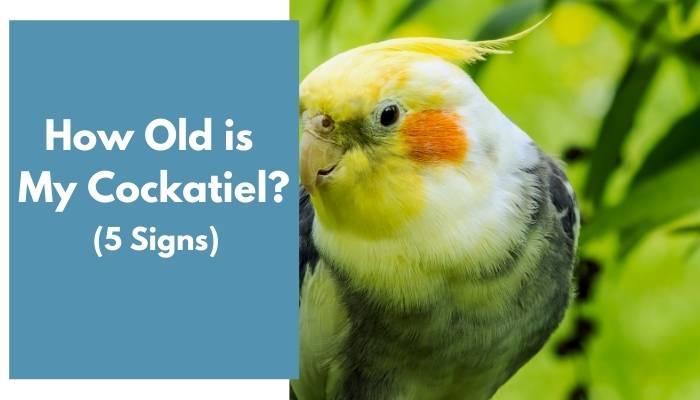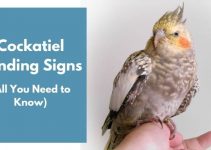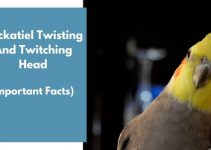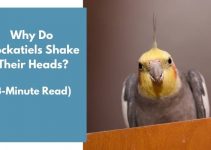Knowing how old a cockatiel is can be a difficult task. It is because these birds only take a while to mature. Once they do, they won’t show any other significant changes. Still, you can observe some signs to learn how old your cockatiel is. If you don’t know your pet’s history, these five signs can help you find it out.
Learning your pet’s age is crucial, especially to pet owners. This way, they can estimate their pet’s lifespan and respond to their needs according to age.
If you wish to know your pet’s age but you have no idea how then this article is for you. Here, you can learn how to tell your pet’s age and other things related to it.
Without further ado, let’s get into it!
Contents
How can you tell how old a cockatiel is?
It’s easy to tell how old a cockatiel is if it’s your own and you have it since it’s inside an egg. However, if you’ve got a fully grown one from a friend, then it can be quite tricky.
Still, if you want to know how old your pet is, you can do so by checking on the following signs.
Leg band or tag
If your pet came from an established breeder, it might have a tag or band on one of its legs.
Such a tag may contain numbers and letters, and these are mostly information about your pet.
Of course, the information may vary depending on the breeder’s preference. Still, you may find the numbers representing the hatching date.
If not, the tag may have a specific identification. Breeders usually keep a record of their birds. Asking them is a sure way to identify how old your pet is.
The development, color, and quality of its feather
Feather indicates many things about birds, and it applies to cockatiels as well. Besides its health, feathers can also tell the difference in age, diet, and even lifestyle.
Of course, you can tell such things quickly at an early age. The reason is that their feathers make most of the changes in this stage. However, as soon as the feathers become full-grown, it won’t be easy to tell.
Newly hatched cockatiels are about an inch long. They have a thin tuft of yellow or white underneath. They’ll start growing some light feathers in the first few weeks.
As cockatiels get two weeks old, they can be four or even five times larger than they were since they hatched. Moreover, the pin feathers begin to open at this age.
As they age up to five weeks, the feathers will begin opening. With almost all varieties, chicks will look like females. They mostly lack that distinctive yellow face that adult males have.
Around six weeks old, they’ll do some flapping as they try to learn how to fly. Thus, the feathers and even their tails can get tattered.
A year-old cockatiel has dull-colored feathers than adults. The tails are also a bit shorter. Males lose the stripes on their ends and start developing bright and yellow faces.
On the other hand, females will keep the barred tails, although it may also have a more distinct color.
As cockatiels get a year older, the coloring won’t change. It will make it impossible to say how exactly old they are. If they receive care and housing, the feathers should be smooth, bright, and undamaged.
You also can’t say that a truly old cockatiel has a difference. Of course, it tends to be a bit duller and low in quality.
However, if you care enough, even an older cockatiel’s feather may seem fair as new.
Your pet’s feet and beak
You can also observe your pet’s age by looking at its feet and beak.
As cockatiels grow older, their beaks turn to be a bit more worn and scuffed. Moreover, the feet can also lessen the smooth texture, becoming a bit more irregular and bumpy.
Of course, there’s no exact way to tell how old they can be just by these attributes. However, birds with adult feathers and a smooth beak and feet are the ones that are only a few years old.
Your pet’s posture and movement
As young people, early age birds are often awkward as they still try to learn how to use their legs and wings. Moreover, they tend to fluff their feathers more and crouch much lower on the perch as they nap.
Older cockatiels may also fluff their feathers more, but they do this act to keep warm.
If you’re looking at this motion, keep in mind that it can also be a sign of sickness. Thus, it would be best to rule out health issues before determining your pet’s age.
Your pet’s energy and playfulness
Your pet’s energy and playfulness is also a sign of youth. Thus, you can consider these aspects when determining age.
Young cockatiels tend to be more curious and playful than adults. Once they turn two or three years older, they may still be lively.
Cockatiels may still enjoy interacting and goofing around. However, their actions may contain a bit more purpose, and they’ll show a certain calmness as well.
As they grow older after some years, they may nap more often. They tend to do this more, especially when they are shedding.
Again, this factor can also be a sign of health complications, so be sure you rule this out too.
Older cockatiels may choose to move less. Further, they may even find it less tempting to fly all the time.
Be mindful that despite the age, cockatiels may become perch birds if they have weight issues.
For this reason, always keep in mind that you should train your pet to have a proper diet no matter what their age is. With proper nutrition and care, a cockatiel will slow down the aging throughout its lifetime.
You May Also Read – Do cockatiels get lonely?
How many years do cockatiels live as a pet?
As a pet, cockatiels can have a long lifespan of 16 to 25 years. It can be as short as 10 to 15 years if you disregard proper nutrition and care.
The most extended lifespan of cockatiels as pets can be for up to 32 years. The oldest one reported even reaching 36 years.
When it comes to lifespan, it all boils down to proper care. As long as you take good care of your pet, you can have a long-term companion with your cockatiel.
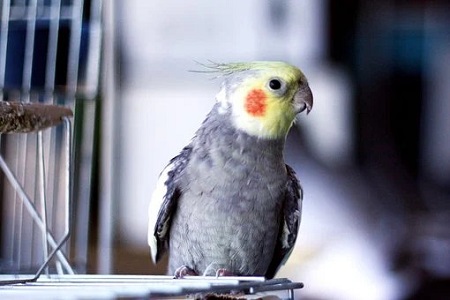
How old is my cockatiel in human years?
Cockatiels, like all other birds, have a different growth than humans. Thus, what seems to be young for us may be an adult for them already. Still, if we are to consider such by using the lifespan, then it can be possible.
For instance, the average lifespan of humans is around 80 years. Since cockatiels tend to live at an average of 16-25 years, then a 10-year-old bird is already an adult.
In reality, cockatiels reach adulthood at one year old. That’s too young for us to be adults since it’s like four years old for us.
Birds of all kinds, including cockatiels, reach adulthood way faster than us. This attribute gives a better chance of survival in the wild.
Of course, there’s no exact telling method when a bird reaches middle-age and even senile age.
Nevertheless, you can still expect the same process to birds as they are to humans. The first stage of their life is where growth and maturity happen.
As they go on, the second stage is more on having some health-related issues. The same goes for humans, as it is in middle age that health complications start to show.
The last stages of their lives show a bit more on declining health. It always happens even to us as we reach old age.
Here are some details about a cockatiel’s life stages.
You May Also Read – How much attention does a cockatiel need?
Cockatiel age stages
Like other birds, cockatiels also have certain age stages. These stages determine what they are capable of doing. At the same time, it also serves as a guide for pet owners as they care for their birds.
Let’s tackle each of these stages.
Hatchling
This stage is the first and the earliest stage of a cockatiel. You can call your pet a hatchling if it is 0-3 days old.
During this stage, your pet doesn’t open its eyes yet, and it may have wisps on its body. Moreover, hatchlings still can’t leave the nest.
Nestling
After the first three days, cockatiels now pass through the nestling stage. This one usually happens within 3-13 days after hatching.
During this stage, the eyes are already open, and the wing feathers may already look like tubes.
The reason is that the feathers aren’t yet breaking through their respective sheaths. Like hatchlings, nestlings aren’t capable of leaving the nest as well.
Fledgling
The fledgling stage happens a day after the nestling stage. Cockatiels of this stage already have feathers. Their wings and tail may be short, and they can’t fly just yet.
Still, during this stage, your cockatiel can already leave the nest and can already walk, hop, or even flutter. Despite leaving the nest, its parents should still be there guiding it.
Weanling
A cockatiel becomes a weanling once it reaches the stage where it can feed on its own.
Weaning for other animals means learning to eat solid food and stops feeding on their parent’s milk.
Since birds don’t feed on their mothers, a weanling cockatiel is the one that provides on its own. Before weaning, their parents feed them by placing the food into their mouths.
In this stage, cockatiels usually learn to fly. It means that a weanling can already move on its own and use its wings.
Juvenile
The juvenile stage happens to a bird when it wears its first complete set of feathers. Thus, as soon as your pet cockatiel gets to wear its full feathers, you can consider it a juvenile one.
This stage ends once your cockatiel starts molting and shedding to replace its original feathers.
Puberty
Puberty in birds can take place depending on their kind. The smaller birds like cockatiels reach this stage between 6 months until they are one year old.
Adulthood
Once your cockatiel reaches a year old, you can already consider it an adult. A bird that’s already one year old and above is already a mature bird capable of breeding.
How to get cockatiel to like you? Learn here.
At what age do cockatiels eat on their own?
Like all other birds and animals, cockatiels of an early age can’t eat on their own. They only start eating on their own once they become a weanling. This stage usually happens around four weeks after hatching.
As I said earlier, weaning for other animals such as cats and pigs means they stop feeding on their parent’s milk and start eating solid food.
Since birds don’t feed on milk, weaning for them means they start eating on their own, rather than getting fed. Feeding for baby cockatiels is putting the food directly in their mouths.
As soon as they become weanlings, they will start looking and eating food on their own.
How to make your new cockatiel feel at home? Check our article.
Summary
Learning the age of your cockatiel is essential to understand how you should care for your pet. Like all other animals, these birds also have specific capabilities depending on their age. Thus, whatever pet you own, we can agree that knowing our pet’s age is vital for us to care better for them.
Like us, cockatiels also undergo the stages of life. Such steps determine what they can do. Although it may be quite challenging to decide on their exact age, we have five main points to consider what stage they are in as of the moment.
Resources
[1] Cockatiel – Wikipedia
